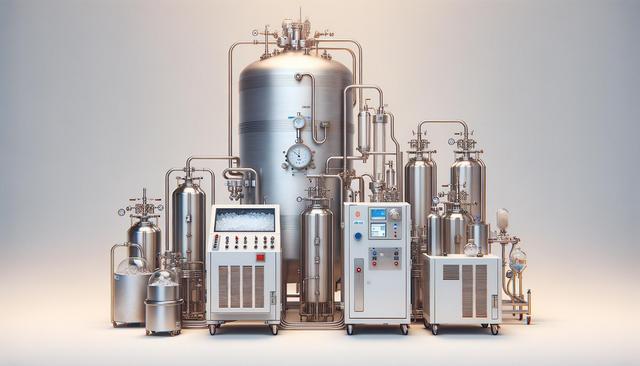Understanding Cryogenic Equipment for Ultra-Low Temperature Applications
Cryogenic Equipment for Ultra-Low Temperature Applications is essential for handling and maintaining extremely low temperatures, often below -150°C. These systems are designed to manage the storage, transfer, and measurement of cryogenic liquids such as liquid nitrogen, helium, and argon. Their ability to deliver stable and controlled ultra-cold environments makes them indispensable in a variety of fields. In medical applications, for instance, cryogenic systems are used to store vaccines, blood samples, and biological materials that require long-term preservation at specific cold conditions. Similarly, research institutions utilize this equipment to conduct experiments in physics and materials science where low temperatures are critical to observing certain phenomena. Industrial sectors also benefit, particularly in the aerospace and energy industries, where cryogenic processes aid in fuel storage and other specialized operations.
Key Components and Technologies in Cryogenic Equipment
The design of Cryogenic Equipment for Ultra-Low Temperature Applications incorporates various specialized components that ensure operational safety and efficiency. Typical systems include:
- Insulated storage tanks with vacuum-jacketed construction.
- Cryogenic valves and pumps designed to function at extreme cold without material degradation.
- Transfer lines that minimize temperature loss during liquid movement.
- Advanced sensors and control systems to monitor temperature and pressure accurately.
One of the most critical aspects of these systems is insulation. Multi-layer insulation (MLI) and vacuum insulation techniques are commonly used to reduce heat transfer and maintain ultra-low temperatures over long durations. These technologies are especially important in applications where temperature stability is non-negotiable, such as transporting cryogenic gases for medical use or supporting superconducting applications in research facilities.
Applications in the Medical Sector
Cryogenic Equipment for Ultra-Low Temperature Applications plays a vital role in modern healthcare operations. Hospitals and laboratories rely on cryogenic freezers and dewars for safe storage of sensitive biological materials. Examples include:
- Preservation of stem cells and reproductive cells for fertility treatments.
- Storage of vaccines and biopharmaceuticals that lose efficacy outside specific temperature ranges.
- Support for cryosurgical procedures that use extreme cold to remove abnormal tissue.
These systems ensure that biological samples remain viable and uncontaminated, which is critical for both diagnostic and therapeutic procedures. Moreover, the increasing use of mRNA vaccines and other temperature-sensitive biologics has expanded the demand for reliable cryogenic infrastructure in healthcare settings.
Importance in Scientific Research and Development
In research environments, Cryogenic Equipment for Ultra-Low Temperature Applications is integral to advancing knowledge in fields such as quantum physics, chemistry, and materials science. Ultra-low temperatures enable conditions under which phenomena such as superconductivity, superfluidity, and Bose-Einstein condensation can be studied. Laboratories often employ:
- Cryostats for maintaining low-temperature conditions during experiments.
- Closed-cycle refrigerators for continuous cooling without the need for liquid cryogen refills.
- High-vacuum systems coupled with cryogenic traps to isolate experimental environments.
These tools allow scientists to observe behaviors that are otherwise invisible at room temperature, leading to breakthroughs in electronics, magnetism, and other advanced technologies. The precision and reliability of the equipment directly influence the quality and repeatability of experimental results.
Industrial Use and Safety Considerations
Industries that demand high-performance cooling and fluid storage solutions also benefit from Cryogenic Equipment for Ultra-Low Temperature Applications. In the energy sector, for example, liquefied natural gas (LNG) is stored and transported using cryogenic tanks that maintain it at approximately -162°C. Similarly, in aerospace manufacturing, cryogenic techniques are used to treat metals and composites, enhancing their strength and durability.
Safety is a major concern when working with cryogenic systems. Operators must be trained in the handling of ultra-cold substances and in recognizing potential hazards such as frostbite, oxygen displacement, and pressure build-up. Standard safety measures include:
- Use of personal protective equipment (PPE) such as insulated gloves and face shields.
- Installation of pressure relief valves and venting systems.
- Routine inspection and maintenance of all cryogenic components.
With proper design and operation, cryogenic infrastructure can deliver both performance and safety, even in the most demanding industrial environments.
Conclusion
Cryogenic Equipment for Ultra-Low Temperature Applications is a cornerstone technology across various high-stakes fields, from preserving life-saving medicines to enabling cutting-edge scientific research and supporting critical industrial processes. Its ability to offer stable, reliable, and safely managed ultra-cold environments makes it an essential investment for organizations operating in these areas. As technological needs continue to evolve, the role of cryogenic systems will only grow in importance, highlighting the need for continued innovation and adherence to rigorous performance standards.




Leave a Reply